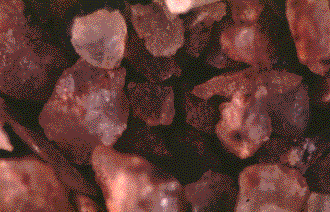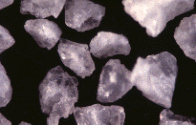
Quartz grains before etching

Quartz grains after etching

Quartz grains before etching

Quartz grains after etching
University of Vermont
PROCEDURE FOR ETCHING BEFORE MINERAL SEPARATION
SAFETY PRECAUTIONS
Both concentrated HF and HNO3 are potentially dangerous acids. Under no circumstances should either acid be allowed to contact the skin, nor should the fumes be inhaled. These acids should be used ONLY in the fume hood and only if the user is wearing FULL protective clothing including eye protection.
1. ALWAYS WEAR GOGGLES WHEN HANDLING ACID
2. ALWAYS WEAR FULL RUBBER SMOCK and THICK NEOPRENE GLOVES. DO NOT WHERE OPEN TOED SHOES (SANDALS) WHEN HANDLING EVEN DILUTE ACID.
3. BEWARE THAT LIDS MAY NOT SEAL TIGHTLY, LIFT BOTTLE BY BASE
4. NEVER WORK LATE AT NIGHT WHEN YOU WOULD BE ALONE.
5. RINSE ANY SPILLED OR SPLASHED ACID IMMEDIATELY WITH COPIOUS AMOUNT OF TAP WATER. USE THE SAFETY SHOWER FOR ANY SPLASH OR SPILL ONTO YOUR SKIN.
6. TIGHTLY CAP HF BOTTLE AFTER EVERY USE. DO NOT LEAVE UNCAPPED EVEN FOR A MOMENT.
7. LEAVE SIGN ON HOOD SO OTHERS KNOW ACID IS BEING USED.
PROCEDURE
1. Pull out eleven 500 ml Savillex Teflon beakers and lids designated for etching. Check each one to see that it is clean of quartz grains. Rewash if necessary. No need to dry. Collect 11 ground and sieved samples. Make two labels for each sample.
2. Label beaker and lid with tape and add a clean polypropylene stir rod to each. Fill each beaker halfway with sample material from one sample (USE 500-800 mm FRACTION IF IT IS SUFFICIENT, add 250 to 500 material only if needed) and write sample name on tape on beaker and lid.
3. Dump contents of beaker into a broad shallow drying tray. Place tray in the sink and turn on the water gently. Use the gentle stream of water and stir. You should adjust the stream so that only the finest material is washed out of the tray as you stir. Continue stirring until the rinse water is clear and the mica no longer floats out of the samples (usually a few minutes). Drain the sample and transfer sample back to the beaker. Fingers may be helpful, just make sure they are quartz free. Repeat for all samples.
FOR MICA RICH SAMPLES, use a large basin and plenty of water attempting to float off the micas.
3. Transfer beakers to hood one at a time. Add 6 N HCl sufficient to cover sample by about 2-3 cm. STIR with stir rod reserved for that sample. Place cap on beaker. Put beaker into Plexiglas cover on the ultra sound. 6 N HCl is a 1:1 mixture of acid and DEIONIZED water. Always add acid to water for safety. Mix up acid in bottle found under the hood labeled with blue tape. USE ONLY BAKER HCl, not TRACEPUR.
4. Fill ultrasound just below gasket level with DEIONIZED water. DON NOT OVERFILL. Set timer for 12 hours. ETCH for at least 8 hours. More etching will not hurt the samples but running ultrasounds low on water will cause large repair bills..
5. After at least 8 hours of sonication, drain beakers into acid neutralization tank. Rinse in hood at least twice with DEIONIZED water stirring with clean stir bar all the way to the bottom of the beaker.
6. TO EACH BEAKER... Add enough DEIONIZED water to cover the sample by 1-2 cm. Ensure that water is still 1-2 above sample surface. Add 15 ml of 50% HF and 15 ml of 70% HNO3. Stir well and replace cover. Put beaker into Plexiglas cover on the ultra sound. Repeat with other beakers. Fill ultrasound just below gasket level with DEIONIZED water. Set timer for 12 hours. ETCH for at least 8 hours. More etching will not hurt the samples.
7. After etching is done, drain off acid to waste container. Tap container lightly several times and drain again. Add about hundred ml of water, stir well, and drain again into waste container. Tap container lightly several times and drain again into waste container.
8. Transfer material from each container into a drying tray moving the beaker or cap label to that tray. In the drying tray, wash each sample with DEIONIZED water a minimum of 5 times. Set the trays in the oven to dry. As soon as material is dry, cap trays and then transfer sample to labeled plastic bag labeled to indicate that material has been etched.
9. If the sample is not quartzite or a quartz vein, place the bag containing etched material into the drawer labeled "need mineral separate".
MAKE SURE THAT COVERS STAY WITH THEIR RESPECTIVE BEAKERS TO PREVENT CROSS-TALK.